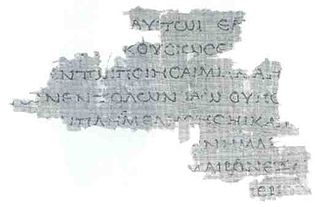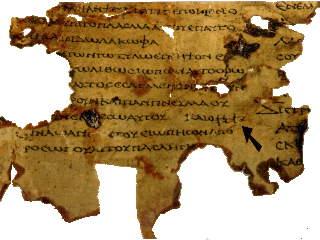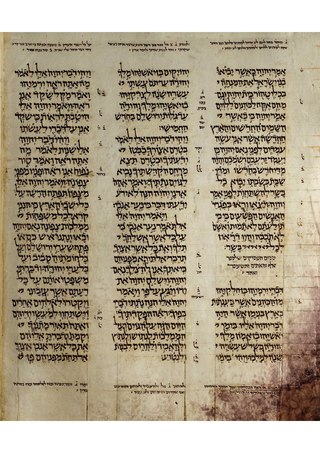Related Research Articles

The Samaritan Pentateuch, also called the Samaritan Torah, is the sacred scripture of the Samaritans. Written in the Samaritan script, it dates back to one of the ancient versions of the Torah that existed during the Second Temple period. It constitutes the entire biblical canon in Samaritanism.

Emanuel Tov is a Dutch–Israeli biblical scholar and linguist, emeritus J. L. Magnes Professor of Bible Studies in the Department of Bible at the Hebrew University of Jerusalem. He has been intimately involved with the Dead Sea Scrolls for many decades, and from 1991, he was appointed Editor-in-Chief of the Dead Sea Scrolls Publication Project.
In contrast to the variety of absolute or personal names of God in the Old Testament, the New Testament uses only two, according to the International Standard Bible Encyclopaedia. From the 20th century onwards, "a number of scholars find various evidence for the name [YHWH or related form] in the New Testament.
4Q108 is a fragment containing a portion of the Song of Songs (3:7–8) in Hebrew. Fragments from three such scrolls were found in Cave 4 at Qumran. These, and 6Q6 from Cave 6, estimated from 2nd century BCE, comprise the total witness to the Song from the Dead Sea Scrolls, known so far.
4Q107 (4QCantb) is a fragment of the Song of Songs in Hebrew found in Cave 4 at Qumran in the Judean Desert in Israel and which comprises part of the Dead Sea Scrolls. The script on the fragment has been identified as early-Herodian. The scribe responsible for 4Q107 did not write 4Q108 as there are differences in writing style. Also, the lacuna in the second column of 4Q107 does not provide enough space to accommodate 4Q108. The fragments which make up the Song of Songs found at Qumran are numbered 4Q106, 4Q107, 4Q108, and 6Q6. The scroll 4Q240 is possibly a commentary on the Song of Songs.
4Q106 is one large and three small fragments from three columns of a scroll containing portions of the Song of Songs in Hebrew. It is one of three scrolls found in Cave 4 at Qumran that have been reconstructed as copies of the Song of Songs. These, and 6Q6 from Cave 6, comprise the total witness to the Song from the Dead Sea Scrolls, known so far.
Discoveries in the Judaean Desert (DJD) is the official 40-volume publication that serves as the editio princeps for the Dead Sea Scrolls. It is published by Oxford University Press.
6Q6 is a small portion of a scroll from Cave 6 at Qumran, containing Song of Songs 1:1-7 in Hebrew. Together with three scroll portions found in Cave 4, they comprise the total witness to the Song from the Dead Sea Scrolls. It is dated to about 50 CE.

The Papyrus Fouad 266 are fragments, part of a papyrus manuscript in scroll form containing the Greek translation, known as the Septuagint, of the Pentateuch. They have been assigned palaeographically to the 1st century BCE. There is discussion about whether the text is original or a later recension of the Septuagint.
4Q41 or 4QDeuteronomyn, also known as the All Souls Deuteronomy, is a Hebrew Bible manuscript from the first century BC containing two passages from the Book of Deuteronomy. Discovered in 1952 in a cave at Qumran, near the Dead Sea, it preserves the oldest existing copy of the Ten Commandments.

The manuscript 4Q120 is a Septuagint manuscript (LXX) of the biblical Book of Leviticus written on papyrus, found at Qumran. The Rahlfs-No. is 802. Paleographically it dates from the first century BCE. Currently the manuscript is housed in the Rockefeller Museum in Jerusalem.

The Greek Minor Prophets Scroll from Nahal Hever is a Greek manuscript of a revision of the Septuagint dated to the 1st century BC and the 1st century CE. The manuscript is kept in the Rockefeller Museum in Jerusalem. It was first published by Dominique Barthélemy in 1963. The Rahlfs-Siglum is 943.

4Q122 – is a septuagint manuscript written on parchment, dated from second century B.C.E.. The scroll contains a fragment of the biblical Book of Deuteronomy 11:4. It was found in a cave at Qumran in Cave 4. This fragment is also referred to as number 819 on the list of the Septuagint manuscripts according classification system by Alfred Rahlfs.
Isaiah 13 is the thirteenth chapter of the Book of Isaiah in the Hebrew Bible or the Old Testament of the Christian Bible. This book contains the prophecies attributed to the prophet Isaiah, and is one of the Books of the Prophets. In the New King James Version, the chapter is sub-titled "Proclamation Against Babylon".

Jeremiah 27 is the twenty-seventh chapter of the Book of Jeremiah in the Hebrew Bible or the Old Testament of the Christian Bible. The material found in Jeremiah 27 is found in Jeremiah 34 in the Septuagint, which orders some material differently. This book contains prophecies attributed to the prophet Jeremiah, and is one of the Books of the Prophets. The New American Bible (NABRE) describes chapters 27-29 as "a special collection of Jeremiah’s prophecies dealing with false prophets", and suggests that "stylistic peculiarities evident in the Hebrew suggest that these three chapters once existed as an independent work".
4Q121 is a Septuagint manuscript written on parchment, dated to the 1st century BCE or CE. The scroll contains fragments of the biblical Book of Numbers 3:40-43; 4:5-16. It was found in Qumran in Cave 4. This fragment is also numbered 803 in the list of manuscripts of the Septuagint by Alfred Rahlfs. The manuscript has been assigned palaeographically between 30 BCE and 68 CE.

The manuscript 4Q127 is one of the Dead Sea Scrolls. It is probably a paraphrase of Exodus according to the Septuagint (LXX) of the biblical Book of Leviticus, found at Qumran. The Rahlfs-No. is 802. Palaeographically it dates from the first century BC. Currently the manuscript is housed in the Rockefeller Museum in Jerusalem.
Dead Sea Scrolls manuscript 7Q1 is an early fragmentary manuscript of the Greek Bible containing verses from the Book of Exodus 28:4–7, written on papyrus. Using the study of comparative writing styles (palaeography), it has been dated to the hasmonean period, about late 2nd-early 1st century BCE.
References
- 1 2 3 Tov 2008, pp. 346.
- ↑ Richey 2012, pp. 181.
- ↑ Dimant 2014, pp. 169.
- ↑ Ulrich 2015, pp. 166.
- ↑ Meyer 2017, pp. 251.
- ↑ Meyer 2017, pp. 252.